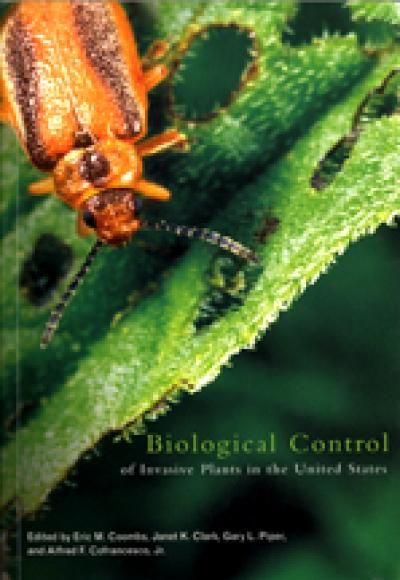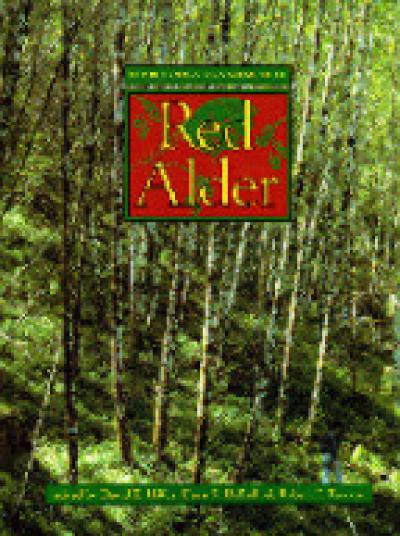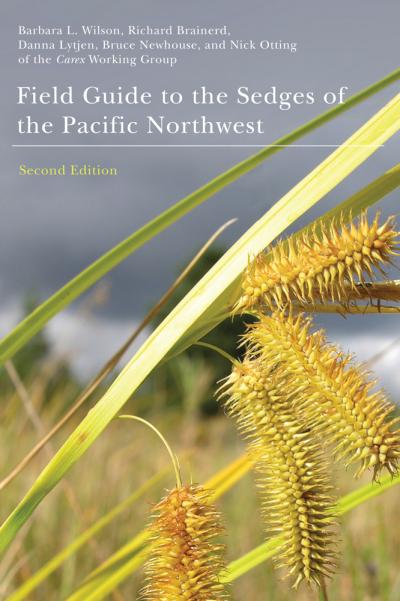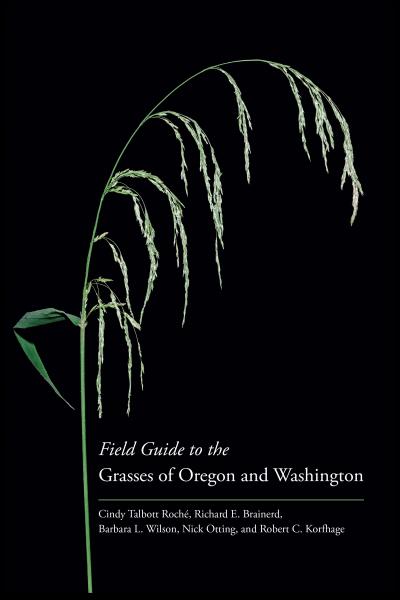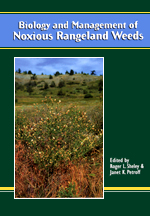
Biology and Management of Noxious Rangeland Weeds
Roger L. Sheley and Janet K. Petroff
The spread of noxious weeds throughout North America is reaching epidemic proportions. The rapid encroachment of these non-indigenous weeds threatens the health, biological diversity, and use of many natural areas, including western rangelands.
In this book, leading weed experts review weed management in light of current knowledge of rangeland ecology and management. Topics addressed include the impacts of weeds, mapping and surveying techniques, economic considerations, prevention, early detection and eradication of weeds, revegetation of disturbed land, and integrated weed management.
In addition to the theory and principles of weed management, this book provides information about twenty-nine of the most serious weeds in the West, including weed identification, origin, history and distribution, invasion potentials, biology and ecology, and specific management options. Full-color photographs and distribution maps help illustrate the plants and the invasive threat they pose.
An invaluable resource for land managers, resource specialists, and students of natural resource management, Biology and Management of Noxious Rangeland Weeds provides practical, science-based information needed for sustainable weed management and land restoration.
Geographic range
United States: Arizona, California, Colorado, Idaho, Iowa, Montana, Nebraska, Nevada, New Mexico, North Dakota, Oregon, South Dakota, Washington, Wyoming.
Canada: Alberta, British Columbia, Manitoba, Saskatchewan
About the author
Roger L. Sheley is Assistant Professor and Extension Noxious Weed Specialist at Montana State University.
Read more about this author
Janet K. Petroff is an agricultural communications consultant in Bozeman, Montana.
Read more about this author
Section I - Theory and Practice of Weed Management
- Introduction
- R. L. Sheley, J. K. Petroff, M. M. Borman
- 1. Impacts of Noxious Weeds on Ecologic and Economic Systems
- Bret E. Olson
- 2. Surveying, Mapping, and Monitoring Noxious Weeds on Rangelands
- Douglas E. Johnson
- 3. Coordinated Weed Management Planning
- Tony Svejcar
- 4. Economic Evaluation Procedures for Noxious Weed Management on Rangeland
- Duane Griffith
- 5. Integrated Weed Management on Rangeland
- Roger L. Sheley, Susan Kedzie-Webb, and Bruce D. Maxwell
- 6. Preventing Noxious Weed Invasion
- Roger L. Sheley, Susan Kedzie-Webb, and Bruce D. Maxwell
- 7. Early Detection and Eradication of New Weed Infestations
- Davild L. Zamora and Donald C. Thill
- 8. Grazing and Weeds
- Bret E. Olson
- 9. Biological Control of Noxious Rangeland Weed
- Linda M. Wilson and Joseph P. MaCaffrey
- 10. Herbicides and Rangeland
- Alvin J. Bussan and William E. Dyer
- 11. Revegetating Noxious Weed-Infested Rangeland
- James S. Jacobs, Michael F. Carpinelli, and Roger L. Sheley
Section II - The Weeds
- Biennial Thistles
- K. George Beck
- Canada Thistle
- Don W. Morishita
- Cheatgrass
- Jeffrey C. Mosley, Stephen C. Bunting, and Mark E. Manoukian
- Common Crupina
- Donald C. Thill, Cindy T. Roche, and David L. Zamora
- Dalmatian and Yellow Toadflax
- Sherry Lajeunesse
- Diffuse Knapweed
- Ben F. Roche, Jr., and Cindy Talbott Roche
- Dyer's Woad
- Erin G. McConnell, John O. Evans, and Steven A. Dewey
- Meadow and Orange Hawkweed
- Linda M. Wilson and Robert H. Callihan
- Leafy Spurge
- Sherry Lajeunesse, Roger L. Sheley, Celestine Duncan, and Rodney Lym
- Mediterranean Sage
- Cindy Talbott Roche and Linda M. Wilson
- Medusahead
- Heather C. Miller, David Clausnitzer, and Michael M. Borman
- Oxeye Daisy
- Bret E. Olson and Roseann T. Wallander
- Poison-Hemlock
- Joseph M. DiTomaso
- Purple Loosestrife
- Barbra Mullin
- Rush Skeletonweed
- Roger L. Sheley, Joseph M. Hudak, and Robert T. Grubb
- Russian Knapweed
- Tom D. Whitson
- Snakeweeds
- Tracy M. Sterling, David D. Thompson, and Kirk C. McDaniel
- Sowthistles
- Richard K. Zollinger and Robert Parker
- Spotted Knapweed
- Roger L. Sheley, James S. Jacobs, and Michael L. Carpinelli
- Squarrose Knapweed
- Cindy Talbott Roche
- St Johnswort
- Gary L. Piper
- Sulfur Cinquefoil
- Peter Rice
- Tansy Ragwort
- Eric M. Coombs, Peter B. McEvoy, and Charles E. Turner
- Whitetop
- Roger L. Sheley and Jack Stivers
- Yellow Starthistle
- Roger L. Sheley, Larry L. Larson, and James S. Jacobs
Contributors
Index
North American rangelands and forests are vast and complex. These phenomenal natural resources sustain food and fiber production, protect watersheds, provide wildlife habitat and recreation sites, maintain a healthy diversity of flora and fauna, and appeal to our aesthetic values and need for open space. Noxious weeds are the foreign organisms--invaders--of forest and rangeland.
Legally, a noxious weed is any plant designated by a federal, state, or county government to be injurious to public health, agriculture, recreation, wildlife, or any public or private property. In this text, we also use the term "noxious" to refer to those weeds that have invasive characteristics, regardless of whether they have been legally designated "noxious" at some governmental level. Long-term ecosystem management is necessary to reduce all weeds' threat to healthy, diverse rangelands and forests.
Most of the weeds invading U.S. rangelands originated in Europe and Asia. Many were introduced to western rangelands during the nineteenth century and are rapidly spreading. New weeds are introduced continually. In ther ecosystem of origin, these plants are not problems because they evolved with natural controls such as insect predators, plant pathogens, fungi, other competing plants, and grazing. Plant species that arrived in North America without those control agents have dominated locations ranging from small, well-defined areas to very extensive, heterogeneous areas. Out competing the native plant community, the weeds create a monoculture that can increase wind and water erosion; decrease capture, storage, and proper release of precipitation; and alter nutrient cycling. Weed monocultures further reduce biological diversity by displacing the macro-and micro fauna that depend on native plants for habitat and food. The grazing capacity of weed-infested land can be reduced by up to 75%.
Weeds prefer highly disturbed sites such as river and stream banks, trailheads, roadsides, building sites, trails, wildlife bedgrounds, overgrazed areas, and campgrounds. Well-managed land is the best defense against the spread of weeds. However, even well-managed land in good condition is susceptible when natural disturbances (such as wind, water, and a wide variety of wildlife, including birds) open niches in the plant community and distribute plant parts and seeds. Once established, weeds are spread by many vectors, including vehicles, wind, recreationists, waterways, animals, and weed-contaminated hay.
Over the years, support for and application of weed management programs have been variable and inadequate. Following the development of phenoxy herbicides at the end of World War II, weed control via herbicides became practical. Initially, the chemical control was also attempted for plants such as Canada thistle (Cirsium arvense) and halogeton (Halogeton glomeratus). Subsequent generations of herbicides provided additional management possibilities. When combined with mechanical control efforts, changes in livestock management, and reseeding with site-adapted plant species, some successes were achieved. However, concern about pesticides' possible detrimental effects on human health and the environment led to increasing restrictions on herbicide use. particularly by government agencies. Federal agency concerns about re-seeding with competitive, non-indigenous species also became a constraint. Interest, budgets, and activity in range weed control all declined because of concern and restrictions. More recently, however, a commitment to addressing the rapid invasion of noxious weeds has been revived and intensified. This book is the result of the increasing interest in noxious weeds. It is meant to provide natural resource managers, and students who are interested in noxious weeds management, with a reference and text.
Section I deals with the theory, concepts, and principles of rangeland weed management. The section is organized in the same fashion as one might develop a weed management plan. An effective weed management plan first considers the impacts of the weeds (Chapter 1). Then managers must survey and map the management unit (Chapter 2). Any sustainable management will require coordinated planning (Chapter 3). The cost and benefits of effective management must be evaluated (Chapter 4). Research indicates that integrating management strategies holds the most promise for long-term success (Chapter 5). Prevention of a weed invasion is the most cost-effective management strategy (Chapter 6), followed by early detection and control of small infestations (Chapter 7). Three management techniques--grazing (Chapter 8), biological control (Chapter 9), and chemical control (Chapter 10)--will be major components of most management programs. And finally, revegetating rangelands is an emerging science (Chapter 11), central to establishing and maintaining weed-resistant plant communities that meet other land-use objectives.
Section II deals specifically with twenty-nine of the most serious noxious weed species in the western United States. Each chapter discusses the identification, origin, and potential invasion of the weed. The ecological and economic effects of each weed are also discussed. Understanding the biology and ecology of each weed provides insights into how to manage the infestation effectively within a dynamic plant community. The chapters conclude with a full discussion of practical management options. The goal is to provide enough information to allow for effective decision-making and weed management planning for the long-term.
A note on the compilation of this book: each of the chapters reflects the knowledge, experience, and interests of its author(s). Therefore, readers will discover a different "voice," different emphases in each chapter. Just as diversity creates a strong plant community, it creates a strong scientific and educational community. We welcome the insights that each author offers. Overall, the format and language of this book is intended to help bridge the gap between weed science and weed management. To a great extent, weed management is a planning process, whereas weed science comprises the theory on which weed managers base their planning. The relationship between these bodies of complementary knowledge seems clear, but the language and application gap can be as wide as the gap between art and science. In this book, the authors have provided practical, science-based information needed for the art of weed management.
The weed distribution maps were created at Montana State University by Lee Faulkner under the direction of Diana Cooksey, Cooperative Agricultural Pest Survey (CAPS) program, funded by USDA Animal and Plant Health Inspection Service Plant Protection and Quarantine (APHIS-PPQ). Data were collected in 1996-97 from various authorities (state Departments of Agriculture, Extension specialists, university researchers, county weed supervisors, Agricultural Experiment Station personnel, etc.) surveyed in each state. The maps do not indicate density of infestations. Rather, the maps show where a given weed has appeared--in any amount--so land managers can be alerted to watch for potential invasions.
Sustainable weed management and land restoration are as complex as the land itself, and involve ecological processes that determine plant community dynamics. Knowledge of these processes, along with economic data, must be compiled into decision-support systems to allow land managers to make informed choices when faced with tough decisions that involve diverse natural resources, land uses, aesthetic values, and budgetary constraints. This book is contribution to building a practical, long-term, decision-support system for land managers.

